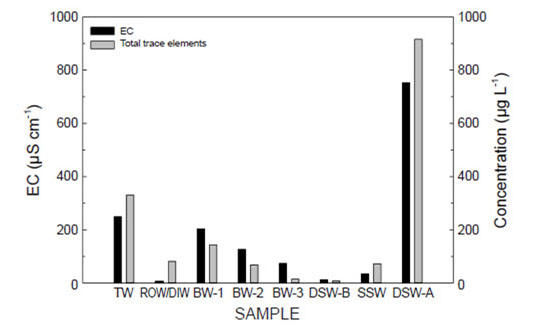All issues

Author:Wen-Jui Liang, Tsung-Ren Peng, Shiou-Yuh Tsai, Ping-Ting Lin, Ping-Yi Huang, Yu-Wen Lin, Chun-Chun Huang, and Tsang-Sen Liu*
Abstract:
To evaluate the mineral characteristics of commercial bottled drinking waters sold locally, their concentrations of major and trace elements were analyzed and compared with those of tap water, deionized water and reverse-osmosis water using the principal component analysis (PCA). Whether PCA can be applied to separate the difference between bottled drinking water and tap water was also assessed. Results showed that, except one kind of seawater-sourced bottled water, concentrations of major and trace elements of examined bottled waters were lower than those of tap water, and levels of some bottled waters were low enough to compete with those of deionized water. Furthermore, PCA can not only distinguish bottled water sourced from terrestrial fresh water or sea water, but also divide fresh water-sourced bottled waters into three different groups, BW-1, BW-2 and BW-3. The mineral characteristics of BW-1 and BW-3 were similar to those of tap water and deionized water, respectively, implying that water sources of BW-1 and BW-3 are highly related to tap water and deionized water, respectively. The characteristic of BW-2 lies between the BW-1 and the BW-3. The most concerned about this study is that there was one kind of bottled water claimed a sea water source exhibiting the mineral characteristics similar to that of deionized water, indicating goods carrying incorrect designation of origin.
Key words:Bottled water, Elemental concentration, Principal component analysis (PCA)
Download:![]() PDF Links
PDF Links
- 1. Development of Tractor-Mounted Seedling Transplanter for Sweet Potato
- 2. Synergistic Effect of Additional Gas on the Toxicity of Phosphine to Sitophilus oryzae and Sitophilus zeamais (Coleoptera: Dryophthoridae)
- 3. Effects of Temperature and Solar Radiation on Growth Traits and Plant Elements in Purple Leafy Sweet Potato
 Submit your manuscript
Submit your manuscript
 Guide for authors
Guide for authors